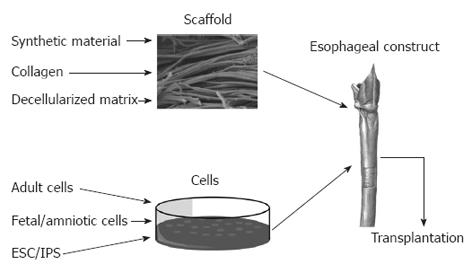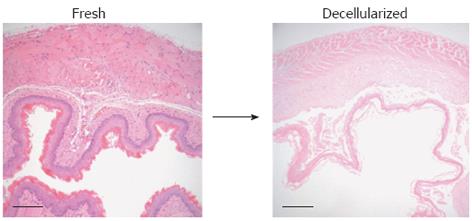Copyright
©2012 Baishideng Publishing Group Co.
World J Gastroenterol. Dec 21, 2012; 18(47): 6900-6907
Published online Dec 21, 2012. doi: 10.3748/wjg.v18.i47.6900
Published online Dec 21, 2012. doi: 10.3748/wjg.v18.i47.6900
Figure 1 Esophageal tissue engineering.
A tissue-engineered esophageal construct may be created by the combination of a scaffold and cells, grown in a bioreactor and transplanted in patients. A three-dimensional scaffold may be created from synthetic material, collagen or a decellularized matrix. Cells for the use of tissue engineering are derived from a number of sources such as the adult, fetus and the embryo. Additionally, non-seeded scaffolds may be transplanted with the aim of being repopulated by host cells. ESC: Embryonic stem cells; IPS: Induced pluripotent stem cells.
Figure 2 Production of esophageal natural acellular matrices.
Decellularization involves treatment of fresh esophageal tissue with a combination of solutions that will remove the cells but maintain the structural characteristics of the native extracellular matrix. The optimal methodology of esophageal decellularization is currently under investigation. Our experience with the detergent enzymatic treatment is illustrated here with hematoxylin and eosin staining of a representative decellularized esophagus demonstrating preservation of the native architecture (Scale bar 100 μm).
- Citation: Totonelli G, Maghsoudlou P, Fishman JM, Orlando G, Ansari T, Sibbons P, Birchall MA, Pierro A, Eaton S, De Coppi P. Esophageal tissue engineering: A new approach for esophageal replacement. World J Gastroenterol 2012; 18(47): 6900-6907
- URL: https://www.wjgnet.com/1007-9327/full/v18/i47/6900.htm
- DOI: https://dx.doi.org/10.3748/wjg.v18.i47.6900










